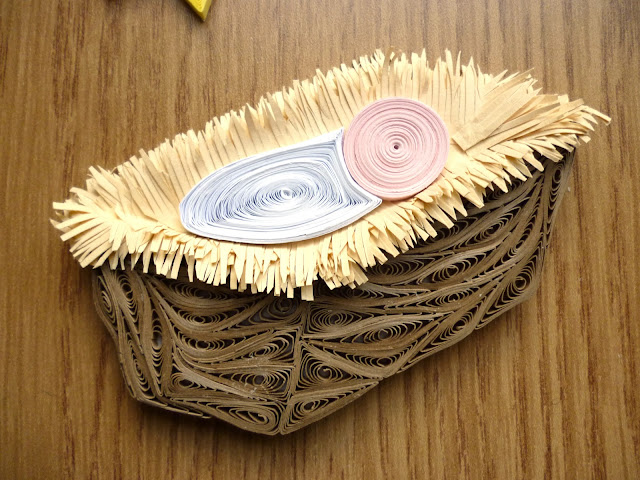Nemrég egy hatalmas projektnek fogtam neki: szülinapi ajándékba készítek egy személyre szabott quilling-naptárt. A naptárnak négy eleme kell legyen, évszakonként csoportosítva a jellegzetes elemeket.
Az első eleme a tél, a naptár kezdetét jelzi a bal felső sarokban a görög ábécé első betűje, az alfa is. A jobb alsó sarokban a hónapok népies megnevezésének kezdőbetűi kapnak helyet: karácsony hava (december), boldogasszony hava (január) és böjtelő hava (február).
A sok apróság közül a legtöbb a téli évszakra jellemző: adventi koszorú lila gyertyákkal, jászol, ami a kis Jézus születésére emlékeztet, fölötte a betlehemi csillaggal, a havas fenyőfa, a sült gesztenye, a sütőtök, az álarc, a cukormázas fánkok. Ezenkívül egy orhidea, mert ez az ünnepelt egyik kedvenc virága, a fekete-fehér-piros virágmotívum azon templom padlójának eleme, ahova az ünnepelt jár, és Erdély címere jelöli a tágabb határú hovatartozását (Gyergyóalfalu egy erdélyi helység).
*********************************************************************************
I recently started a big project: a quilled calendar as a birthday gift for someone. The calendar should have four elements, each one representing a season. This is the first one, the winter, as you can see the alpha (the first letter of the greek alphabet) in the upper left corner symbolizing the beginning. There are some elements that are representative for this season (the months of december, january and february) as well as christianity: the wreath of advent with four purple candles that stand for the four weeks of expectation before Christ's birth, the manger and the star of Betlehem symbolizing His birth, the snowy fir, the roasted chestnuts, the pumpkin, the mask for the masquerade ball and the sugarcoated doughnuts. Besides these there's an orchid, one of the bithday girl's favourites, a black-white-red flower motif that she should recognize from the church floor that she attends, and Transilvania's coat of arms, because she's from a transilvanian village called Gyergyóalfalu (Joseni in Romanian).











Wow, Eva - this is incredible! Such detail & precision, and a wonderful gift idea :)
ReplyDelete